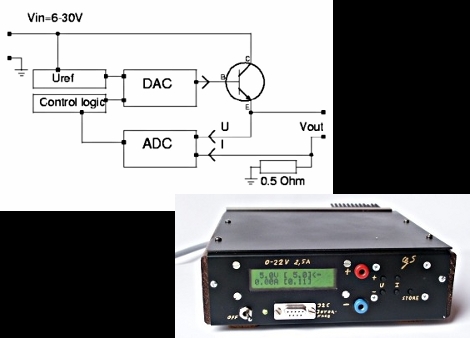
[Scott’s] been digging around the back issues of the Internet to find this project. He blew the dust off and sent us a link to an article that traverses the design and build process of a bench power supply.
[Guido Socher] does an excellent job of presenting his bench supply project. So many others show of the final product, but he has gone out of his way to make sure we understand the design principles that went into it. He starts off by talking about the simplest possible supply design: a transistor and Zener diode which generates a reference voltage. He goes on to discuss the problems with this simplified circuit and how to address them, covering the gotchas that pop up at each step in the process.
Once he designed the circuit and laid out some boards he began building an enclosure. We love his tip about using a stick pin and an unpopulated through-hole PCB to mark button locations on the front bezel of the case. The final design is shown above, and includes a laptop brick to translate mains power into a 24V 3A DC feed for his custom circuitry.















Uh, wasn’t this posted two days ago?
http://hackaday.com/2011/06/06/diy-digital-bench-power-supply/
Actually, it’s the older version of what was posted a few days ago it…
I call that professional short term memory loss.
Got my hopes up for a minute.. I’ve seen lots of bench power supplies that can be made at home, but nothing that approaches the capabilities and flexibility of the real supplies that cost hundreds. I’d settle for “approaches”…
my first thought: that looks like a buck converter minus the inductor.
– ok, no pwm-output that has a mosfet switching the power on and off, instead a linear regulator. if you want that, the whole circuit could probably replaced by a linear regulator ;)
or a buck converter (~$1 ?) with the output connected to the transistor and an additional RC to ground with a time constant that matches the frequency of the pwm.
I built a newer version of this power supply (that he sells the kit for online) a while back. It’s worked quite well and my multimeter shows that its voltage and current regulation is quite accurate.
@tantris: no, it is a linear regulator just one that’s controlled by a microcontroller. It also has current feedback as opposed to a limiter, so I guess it could be programmed to do constant power which is something most professional bench PSUs can’t do. And it talks to a PC.
I’m pretty sure this one appeared in Elektor mag not so long ago and they do a kit for it too.
Is this supposed to be funny?
I’m pretty impressed with his build log. I dropped out of electrical engineering to do biology, but even with the year of basic circuits and theory that I learned, as well as the physics course that I had to take for biology, I can understand most of what he’s saying. Enough to the point that I actually want to try building one with all the random spare parts I have laying around. I may have my degree in biology now, but I can’t resist the lure of electronics :)
@nes: Look up what a linear regulator is. The feedback loop on this device is digital.
And that is not the way to do a lab power supply. By the time the current limit kicks in, the circuit you are powering could already be fried.
LOL! I submitted that link to HAD about 3 months ago… weird system they’ve got going here! I figured they finally got to it when it showed up 2 days ago, without my name (lol?)
@uzerzero – please email me! I did the same thing. I did engineering for 6 months, switched to biology, just got my masters in molecular biology and now I’m half way through dental school. I’d love to hear your story!
What I like most about this project is the case and display. gonna have to read more about this!